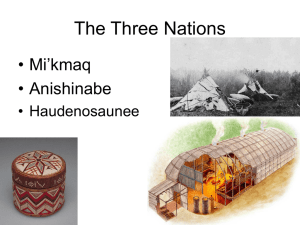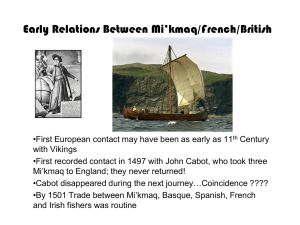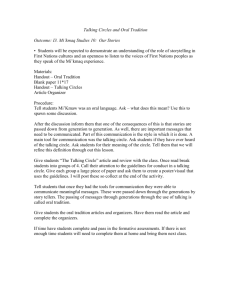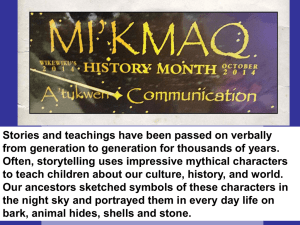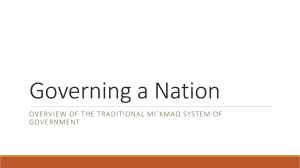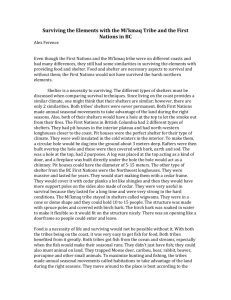Bridging Sacred Canopies: Mi'kmaq Spirituality and Catholicism.
advertisement
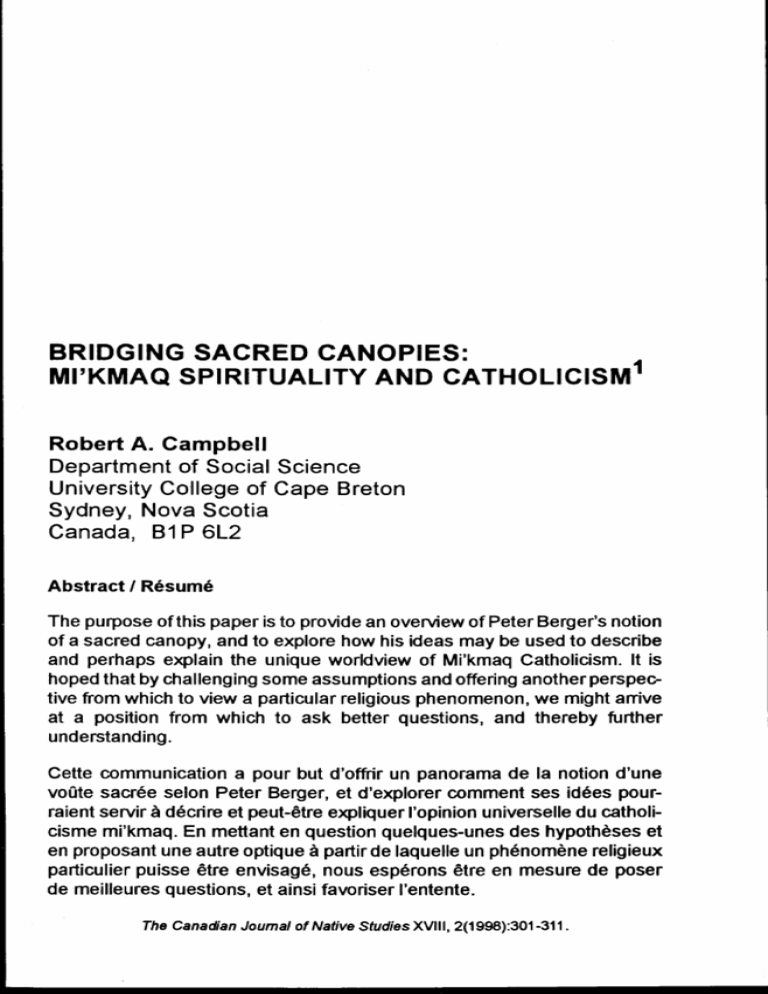
BRIDGING SACRED GANOPIES: MI'KMAQ SPIRITUALITY AND GATHOLICISM1 Robert A. Gampbell Department of Social Science University College of Cape Breton Sydney, Nova Scotia Canada, 81 P 6L2 Abstract / R6sum6 The purpose of this paper is to provide an overview of Peter Berger's notion of a sacred canopy, and to explore how his ideas may be used to describe and perhaps explain the unique worldview of Mi'kmaq Catholicism. lt is hoped that by challenging some assumptions and offering anotherperspec. tive from which to view a particular religious phenomenon, we might anive at a position from which to ask better questions, and thereby further understanding. Cette communication a pour but d'offrir un panorama de la notion d'une vo0te sacr6e selon Peter Berger, et d'explorer @mment ses id6es pourraient servir d d6crire et peut-Otre erpliquer I'opinion universelle du catholicisme mi'kmaq. En mettant en question quelques-unes des hypothdses et en proposant une autre optique i partir de laquelle un ph6nomdne religieux particulier puisse 6tre envisag6, nous esp6rons 6tre en mesure de poser de meilleures questions, et ainsi favoriser I'entente. The Canadtan Joumal of Native Sfudies XVlll, 2(1998):301-311 . 302 Robert A. Campbett Much of what has been written in recent years on the religion of the Algonkian peoples of the Northeast United States and Eastem Canada has centered on the historical factors that led to the displacement of Native spirituality by the secular ideas and Christianity of colonial forces (see Morrison, 1984; Albanese, 1gg0; chute, 1gg2; Reid, 1g95; parkhill, 1gg7). At the same time, however, much of this literature suggests that what took place reflects the ways in which both native North Americans and the colonists responded to the new conditions that confronted them. So, for example, Jennifer Reid (1995) talks about the alienation between colonists (and their descendants) and Native peoples that arose out of the British encounter with the Mi'kmaq in the period from 1700 to 1967. Thomas Parkhill (1997) analyzes the way in which, about one hundred years ago, Charles Leland attempted to create a mythic history for Americans, by distorting the Algonkian stories about Glooscap. Catherine Albanese (1g90) indicates that, more recently, many of the stories, rituals, and sacred places of Native peoples, that had been displaced by the colonists, are being repackaged and adapted to the needs of various New Age enthusiasts, Native and \Mrite. All of these examples point to the fact that we might gather greater insight into contemporary Native religion by examining the adaptive strategies employed by Native peoples that gave rise to contemporary beliefs and practices. As Kenneth Morrison (1gg4:6) argues, "even under the disruptive conditions of contact the Abenaki shared with the European a driving need to maintain social order." This motivating force is no less evident today. consequenily, for the purposes of this paper, I am not concerned with placing blame or rewriting history. Rather, my concern is with understanding how the presentday phenomenon of Mi'kmaq catholicism developed in response to the need for order. I do not claim to enter these debates as someone with particular expertise in mattens pertaining to the Mi'kmaq or to the broader area of Native American religion. Rather, I profess to be a sociotogist of religion, and, as such, lthinkthatsome of the lessons leamed in trying to understand the social aspect of religion in other settings might help us to draw out and express some features of Mi'kmaq spirituality. I think that this is especially important given the unique character of Mi'kmaq Catholicism, and I would hope that my efforts are viewed as a step towards facilitating communication between those inside this particular community of faith and those outside (like myself). As part of my anarysis, I make no claims about the truth or falsity of religion, and t make no effort to contribute to or become involved in the ongoing arguments in the academy about the appropriateness of "non-Natives" studying "Native" retigion (see parkhill, 1gg7). Rather, this papershould be viewed as more of a programmaticstatement, Mi'kmaq Spirituality and Catholicism 303 outlining one of many possible avenues along which to explore what is one of the most complex and yet integral aspects of social life, in all contexts, namely, religion. As a first step, I want to comment on the writing system that is at the heart of the uniqueness of Mi'kmaq Catholicism. David Schmidt and Murdena Marshall (1995) provide the first readily available edition, with English translations, of the Mi'kmaq hieroglyphic prayers which have been in use for overthree hundred years. Not only do these hieroglyphics represent the first instance of an Indigenous script in North America, the prayers continue to serve as a teaching tool and a link from generation to generation for passing down a unique religious and linguistic heritage. Ever since the conversion of Grand Chief Membertou in 1610, Catholicism has been an integral element of Mi'kmaq life, with only about five percent of the present Mi'kmaq population claiming non-Catholic status. Following the Treaty of Utrecht in 1713, which split the Mi'kmaq territory between the French and English, the Mi'kmaq 'Were fighting for the integrity of their homeland, Mi'kma'ki, their right to worship freely and have Catholic priests, and, as they perceived it, theirsurvivalas a people" (Schmidt and Marshall, 1995:8). ln this respect, Catholicism and the hieroglyphicsystem became, forthem, a way to distance themselves from the conquering British (see Dickason, 1986). Research on the hieroglyphic system, linguistic and othenntise, is in its early stages, but our present concern is with the social aspect of religion. The sociology of religion differs fom other approaches to religion, whether historical, phenomenological, or theological, in that it is primarily concemed with examining the social role of religion. As Malcolm Hamilton (1995:1) indicates, the sociology of religion is concerned with exploring why religious beliefs and practices are such a central feature of culture and society, and why they take such diverse forms. The kinds of answers to these questions offered by sociologists have generally been based on the empirical study of the members of various religious groups. Often these studies take the form of sample surveys, through which researchers attempt to quantiff and characterize the various beliefs that people ascribe to and the practices that they engage in. ln other instances, ethnographic researchers attempt to offer a more qualitative picture of how religious affiliation or belonging plays out in people's everyday lives, as part of a community. This paper is not @ncerned as much with the direct empirical study of religion, as it is with trying to present a conceptual framework within which the empirical investigation of the phenomenon of contemporary Mi'kmaq Catholicism might be carried out. There is much here for sociologists of religion to learn, as Mi'kmaq Catholicism presents what appears to me at 304 Robert A. Campbell leastto be a unique blending of Native spirituality and historicalChristianity. The conceptual framework that I am advocating is one that was presented thirty years ago by Peter Berger, in his book The Sacred Canopy (1967). That is, I advocate a social constructionist view of religion, not in order to claim that religion is purely a social construction, and thus lacking truth, but to show that our understanding of religion is constructed in such a way as to reflect the processes of interaction and interpretation that we engage in as members of social groups. Following a discussion of Berger's ideas, I use the examples of St. Anne and Glooscap to offer concrete illustrations of how research might proceed. The Sacred Canopy Peter Berger (1967) uses the symbol of the sacred canopy to describe the system of meanings within which we live out our daily lives, and which provides a sense of order for our own society and for the larger world of which oursociety is part. Berger refers to the meaningful order of this world as a nomos into which we are socialized, and which eventually we learn to take for granted. In other words, we learn to see ourworld and our place in it as something objective and given. This nomos provides not only explanation, but also prescription. That is, it describes for us not just how things are, but how they ought to be. Problems arise when we encounter objects that cannot be readily explained, or when we interact with people who may have a very different worldview from our own. Extreme instances of this include such things as war, natural disasters, or death, but the encounters between Native North Americans and colonists would certainly qualiff as problematic for both sides. At these times, our nomos is threatened, and the world may no longer seem to make sense. Berger (1967:42) argues that these marginalizing situations can be dealt with most effectively, when our particular nomos is seen as part of a much larger and timeless cosmos. By seeing ourselves and our world within the broader context of a transcendent and immense universe of meaning our problems look much smaller and much less threatening. Even when individuals or even whole societies have passed awaythe largerorderwill still be maintained. How is it, then, thatwe come to see our world within this broader context? Berger (1967:25) argues that religion is the institution or mechanism that locates human phenomena within a cosmic frame of reference. Metaphorically, then, the umbrella of meaning that shelters us from our fears and allows us to carry on when our immediate world of experien@ is threatened is best conceived of as a sacred canopy. The stronger the link to the sacred, the stronger and more resilient our nomos will be. Mi'kmaq Spirituality and Catholicism 305 Just as children and new members of a society need to be socialized into a particular nomos, all members of society need periodic reminders of those beliefs and actions that provide order. This is particularly the case, because we have little or no experience of the cosmic world, and so it is easy to get lost in the day to day workings of this world, and lose track of the larger context of meaning. Berger (1967:37) cites the Arablc proverb, that God remembers, people forget. \Mthin the context of Christian conF munities, this is the point of going to church on Sunday, or celebrating other events throughout the year, such as Christmas or Easter. On these occasions, we are reminded of the way things are and the way things should be. Our actions in the world become re-oriented wilhin the transcendent order of the cosmos, and the future continuance of the social order is ensured. As Schmidt and Marshall (1995:10) indicate, even when missionaries were away from Native communities for a number of years, the Mi'kmaq people kept their Catholicism alive through the use of their prayer books. Today, the festivities around St Anne's Day (July 26) also serve this important function. Bergefs ideas extend well beyond the brief sketch I have just provided, but I think it is important at this point to place this discussion within the context of some concrete examples. St. Anne St. Anne, the mother of Mary and thus the grandmother of Jesus, is never mentioned in the Bible, and in fact she remained a rather marginal figure in Roman Catholic Christendom until medieval times (see Attwater, 1965:186). Contemporary celebration of St. Anne is nearly non-existent in most Roman Catholic countries, but is especially strong in Canada. The story of the parents of Mary, whose names are given as Joachim and Anne, is told in an obscure infancy nanative from the second century, generally referred to as the Profevangelium of James (Barnstone, 1984:385-392). The James refened to in the title, and the purported author of this text, is James the brother of Jesus, who, one might imagine, could have had firsthand knowledge of his grandparents. \Mrile this practice of attributing texts to authoritative figures was common at that time, the writer is most certainly of Jewish ancestry, writing for a group of Jewish converts to Christianity. The objective of the text is to provide the kind of information that the members of this particular community need in order to see Christ as filting into their nomos, and thus tie them as a @mmunity of believers into the broader sacred canopy of emergent Christianily. The model used for this text is the story of the birth of Samuel found in the first chapter of the first book of Samuel in the OH Testarnent (see 306 Robert A. Campbell Attwater, 1965). In this story, Hannah (Anne) is old and without children, and so she prays to the Lord to be blessed with a son. In return, she promises that strong drink shall never pass his lips and his whole life shall be dedicated to the Lord, to do God's work. Similarly, in the text attributed to James, the parents of Mary are old and without children. In this case, Joachim engages in a period of fasting and devotion, afterwhich the couple is blessed with the birth of a girl, who shall become the handmaid of the Lord. In both cases, the advanced age and childlessness of the parents can be seen to represent the threat of community extinction. God provides for continuance, in response to ascetic devotion. In the case of Hannah, it is Samuel, the child to come, that will perform this service, and in the case of St. Anne, it is her husband Joachim and her child Mary who both have a part to play in this. Certainly within the context of Judaism, where ethnic identity is passed down through matrilineal ties, the kind of legitimation that these stories provide would go a long way towards demonstrating a linkage between events in this world and the broader unfolding of history on a cosmic level. Tuming now to a Mi'kmaq legend, Charles Leland ([18S4] 1992:61; Leland and Prince, 1902:164-165) presents a story of how Glooscap, through fasting and living an exemplary life, is able to bring grandmother back from death. Here, we see an interesting variant on the Judeo-Christian versions of this story. With Hannah and St. Anne, asceticdevotion is offered so that God will ensure that tradition and a community's nomos will not be lost. In the Glooscap story, ascetic devotion is offered so that God will in a sense establish a tradition for the Mi'kmaq through a miraculous event. In other words, through this story, the Mi'kmaq establish a parallel tradition with the one being presented to them by the Christian colonists. In this way, the ethnic identity of the Mi'kmaq people is not seen to begin with Glooscap, but rather is tied back into a more transcendent and timeless orderthrough grandmother. I would speculate, in this regard, that the Protestant Christianity of the English, with its emphasis on breaking with tradilion and establishing a more independent (human-centered rather than God-centered) approach to the world, would have seemed much more'Toreign"than the view being presented by the French Catholics. lt is important to realize, as has been pointed out by Morrison (1984) and others, that both the Mi'kmaq and the colonists (whether English or French) would have found their experiences of encounter perplexing and anxiety inducing. Thus, all parties would have been involved in an effort to (re)establish a sense of order, that would allow them to carry on in this "new" world in which they found themselves, and from which there was no tuming back. Mi'kmaq Spirituality and Catholicism 307 On a more practical level, St. Anne and grandmother are seen to fulfil paraffel roles in the maintenance of the community. Janet Chute (1992:5253) explains that the capabilities associated with grandmother, which underline the need to respect the potential for healing and renewal in even the old and incapacitated, bear close associations with the revitalizing powers ascribed by the Micmac to St. Anne, who aids infants, the elderly and mothers in child-birth. So, the story is significant on two levels. In bringing grandmother back from death, Glooscap is instrumental in establishing order in this world, and through this action he is certainly linked to the diMne. Through the story of grandmother, the Mi'kmaq are not only acknowledging that the larger cosmic order extends well beyond him and beyond them, they are providing themselves with concrete practices and beliefs through which to integrate these conceptions into their daily lives. This same kind of humility in the face of something greater is evident in some of the events related to the feast of St. Anne. Chute (1992:56) indicates that this celebration has been an occasion when leaders have been subjected to public scrutiny, to ensure that their aspirations match those of the people they represent. As with the European notion of divine kingship, the leader must come clean of any wrongdoing, whether actual or perceived, because the leader embodies meaning forthe community and must stand both for what is and what ought to be. I want to continue this theme of leader:ship, and at the same time get to the story that got me thinking about these matters in the first place and in fact provides the title for this paper, bridging sacred canopies. Glooscap and Jesus As alluded to above, leadership can be seen to have a dualaspect, part of which manifests itself in practical action in the world, and part of which reflects a more transcendent element of linkage to some higher, often divine, authority. As leaders, Glooscap and Jesus, both of whom are viewed as not fully "of'this world, are certainly seen to operate "in" this world. Through the stories contained in scripture, Christians learn to see Jesus as both human and divine. Similarly, there are a number of legends linking Glooscap directly to Europe and to Christianity, that serve to illustrate both his divine and human aspeds. For example, one story tells how Glooscap predicted the coming of the Europeans, and how he also predicted that the Mi'kmaq would be baptized (see speck, 1915:60). Another legend tells of how Glooscap sailed to England and France long ago, and made the 308 Robert A. Campbell Europeans aware thatthere existed a land acrossthe greatsea (see Leland, 1992:127-130). This legend includes an account of the French trying to shoot Glooscap out of a large cannon and how after the cannon was fired, Glooscap was found sitting in the barrel unharmed and smoking his pipe. A similar story tells how the King of England tried to burn Glooscap on a great pile of logs (see Wallis and Wallis, 1955:333-334). As with the previous story, afterthe fire, Glooscap is found to be unharmed, peacefully enjoying his pipe. All of these stories indicate that the sacred canopy of the Mi'kmaq provided a way for people to deal with the threats posed by exposure to both Catholic Christianity and European political powers. The Mi'kmaq saw that there was no need for one sacred canopy to replace another. Rather, there was a way to bridge these canopies and establish a broader framework of meaning within which to see the world. Here again we see evidence of how the Mi'kmaq alignment with Catholicism, let alone with the French, must have been extremely unseftling to the Protestant English. Perhaps the central illustration of the progr:am I am trying to outline is the story of the contest between Glooscap and Jesus. lt goes as follows: [Christ] took Gluscap to the ocean, and told him to close his eyes. Then Christ moved close to the shore an island which lay far out to sea. \Mren Gluscap opened his eyes, he saw it. Christ asked him if he could do as much as that. Then Gluscap told Christ to close his eyes a while. \Mren Christ opened his eyes, he found that Gluscap had moved it back to its place again (Speck, 1 91 5:60-61). I do not view this is a contest between evenly matched contestants, but as a metaphor for the klnd of relationship that the Mi'kmaq realized could exist between themselves and the Catholic Europeans. Glooscap did not try to outdo Christ by moMng the island elsewhere, orselecting some otherobject to tamper with. Rather, by returning the island to its place, Glooscap was showing Christ that Mi'kmaq religious belieF and practices did not need to be displaced in order for a new and ostensibly more encompassing worldview to be introduced. The existing worldview was already large enough and flexible enough to accept the Christian worldview. That is, while the Christian worldview may have added new information and formed the basis fora more nuanced view of aspects of creation, it did not displace orreplace what was there already. The cosmic order was still intact and so was the nomos within which the Mi'kmaq people lived out their lives. \Mrat had changed was the way that this meaningful order was oonstructed and maintained through religious stories, beliefs, and practices. Mi'kmaq Spirituatity and Catholicism 309 In his book, Beger (1967) continuatly emphasizes the importance of ongoing conversation in the establishment and maintenance of meaningful order. In other words, it is through processes of social interadion and interpretation that our views of the world, and our place in il, are expressed, reacted to, modified, and passed on. Berger even goes so far as to suggest that to cease this ongoing conversation is to cease to exist. The ways in which the Mi'kmaq blended elements of their own pre-colonialtradition with the Catholic worldview presented to them by the French, in a way that provided them with an acceptable view of history and of the future, offers ctear support for Berger's ideas. lf we are to understand more fully the nature of Mi'kmaq Catholicism and the spirituality at the heart of it, this understanding is most likely to emerge out of our participation in the ongoing conversation that began atthe point of first contact between Europeans and the Mi'kmaq people. Summary Berger's notion of the sacred canopy provides the ideal conceptual framework within which to study Mi'kmaq Catholicism in a way that reflects a spirit of mutual respect and humility in the presence of some greater power. The continued use of the hieroglyphic prayer books and the festivities associated with St. Anne demonstrate that ongoing processes of social interaction and interpretation play an extremely important role in the development and malntenance of cultural identily. Consequently, it is overly simplistic to assume that a cultural phenomenon like Mi'kmaq Catholicism was imposed from outside, or arose in response to structural constraints. These latter views support a view of Mi'kmaq Catholicism as an anachronistic product, a vestige of earlier times. I would argue that it is more appropriate to view this phenomenon spiritually, as a process full of life, that is very much a part of who the Mi'kmaq people are. This brief study, however, has been too cursory for me to claim that major conclusions can be drawn from it. Rather, my intention was to point to an alternate approach that will allow scholars to erplore Christianity, particularly Roman Catholic Christianity, in its relationship with Native spirituality, in a way that respects the members of the communities of faith. \Mrile historical and political analyses have provided insight into many aspects of Native-\Mrite relations, they cannot explain away the manner in which Mi'kmaq Catholicism manifests itself in the here and now. 310 1. Robert A. Campbell Notes An earlier version of this paper was presented at Mi'kmawey 1997, held at the University college of cape Breton, sydney, Nova scotia, October 10-12.1997. References Albanese, Catherine 1990 Nature Religion in America. From the Algonkian tndians to the New Age.Chicago: University of Chicago press. Attwater, Donald 1965 A Dictionary of Sainfs. London: penguin. Barnstone, \Mllis 1984 The Other Bible. New York: Harper Collins. Berger, Peter 1967 The Sacred Canopy. New York: Doubleday. Chute, Jane Elizabeth 1992 Ceremony, Social Revitalization, and Change: Micmac Leader- ship in the Annual Festival of St. Anne, pp. 45-62 in \Mlliam Cowen (Editor): Papers of the Twenty-Third Algonquian Conference. Dickason, Olive 1986 Amerindians between French and English in Nova Scotia, 17131 763. American lndian Culture and Rese arch Journal 1 0:31 -56. Leland, Charles Godfrey 1992 The Algonguian Legends of New England, or Myths and Fotklore of the Micmaq Passamaquoddy and penobscof rribes. New York: Dover. Hamilton, Malcolm 1995 The Sociology of Religion: Theoreticat and Comparative Per- specfives. London : Routledge. Leland, Charles Godfrey and John Dyneley Prince 1902 Kuloskap the Master: And other Algonkin poems. New york and London: Funk and Wagnalls. Morrison Kenneth 1984 The Embaftled Northeast: The Etusive ldeat of Attiance in Abenaki-Euramerican Relations. Berkeley: University of Califomia Press. 311 Mi' kmaq Spirituality and Catholici sm Parkhill, Thomas 1997 Weaving Ourselves rnfo the Land: Charles Godftey Leland, lndians, and the Study of Native American Religions. Albany, NY: SUNY Press. Reid, Jennifer 1995 Myth, Symbol, and Colonial Encounter. Ottawa: University of Ottawa Press. Schmidt, David L. and Murdena Marshall 1995 Mi'kmaq Hieroglyphic Prayers: Readings in North America's First lndigenous Scnpf. Halifax Nimbus. Speck, F.G. 1915 Some Micmac Tales from Cape Breton lsland. The Joumal of American Folklore 28:59-69. Wallis, \Mlson D. and Ruth Sawtell Wallis 1955 The Micmac lndians of Easfem Canada. Minneapolis: University of Minnesota Press.

